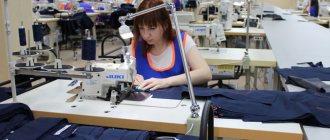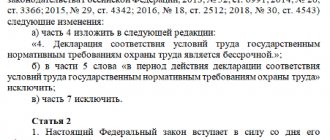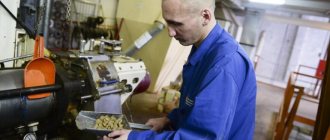The Special Assessment of Working Conditions (SAL), which replaced workplace certification in 2014, made noticeable adjustments not only to the approaches to the procedure, but also to the process of assigning benefits and guarantees based on its results.
During the active conduct of special assessments at Russian enterprises, it was possible to accumulate considerable law enforcement practice and make many court decisions of various directions.
But cases of non-compliance with legal requirements within the framework of special assessment work still remain quite common. Expert organizations are to blame for many miscalculations, but most of them are made by employers and commissions for the implementation of SAW at the very early preparatory stage.
What should be understood by SOUT
A special assessment of working conditions is a whole complex of measures carried out one after another aimed at identifying dangerous and/or harmful factors in the production environment and assessing the degree of their impact on the employee, taking into account the actual values of their deviations from the standards approved by the Government of the Russian Federation for the organization of safe working conditions.
Federal Law dated December 28, 2013 No. 426-FZ classifies almost all workplaces at enterprises, organizations, firms into a category for which it is mandatory to evaluate the working conditions provided to employees according to a special scheme, with the exception of the following cases.
For which categories of employees is it allowed not to carry out a special procedure for assessing the provided working conditions for employees (clause 3, article 3 of the Federal Law of December 28, 2013 No. 426-FZ)
- employees working remotely;
- workers working from home (homeworkers);
- workers whose employers are not individual entrepreneurs;
- workers whose employers are religious organizations.
In addition, there is a legally established list of individual places of work in enterprises with certain types of activities that have specific properties, for which a special procedure must also be carried out to assess the proposed working conditions for workers (Resolution of the Government of the Russian Federation dated April 14, 2014 No. 290 ). Carrying out a special procedure for assessing the impact of working conditions on an employee in such cases is carried out taking into account those features that are established by the authorized body of the federal executive power.
List of enterprises (departments) that carry out certain types of activities, when conducting a special procedure for assessing the impact of working conditions of workplaces on employees where the features established by the federal executive body apply:
- Vessels:
– sea;
– river;
– inland navigation vessels;
- engaged in fishing.
- Civil aviation vessels.
- Organizations providing emergency (specialized) care.
- Intensive care units, intensive care units, operating rooms.
- Departments of medical institutions for performing diagnostics and direct treatment using special medical equipment (instruments, devices, equipment, etc.).
- Organizations that prepare for sports competitions.
- Media, theaters, circuses, etc.
- Enterprises with nuclear and radiation hazardous industries.
- Enterprises related to organizing the work of divers.
- Enterprises whose activities are carried out in the field of extreme exposure to the gas environment and air environment.
- Enterprises associated with underground work.
- City passenger transport.
- Medical departments providing assistance to patients with mental disorders.
- Enterprises that operate in the areas of manufacturing, testing, processing, disposal and storage of explosives.
Workplaces with individual characteristics subject to special safety standards
Such areas include professions from list No. 1 and No. 2, established by law. For these areas of work activity, the procedure should always be carried out regardless of the results.
Certification of workplaces or special assessment of working conditions
It is this category of work activity zones that is treated with special close attention, since they act as a means of replacing certification with SOUT. Such innovations relate to issues of objectivity in the provision of guarantees and compensation. In a situation where the workplace is recognized as safe, all compensation payments are terminated for the duration of the validity of the results of the SOUT. In a situation where the next inspection again shows the danger of such work zones, benefit payments begin anew.
There is a special category of work zones with special types of activities. For example, steeplejacks, pilots, divers, workers from the nuclear industry, etc. SOUT for these areas of work is not carried out taking into account the specifics provided by the Ministry of Labor of the Russian Federation.
Example. It is prohibited to carry out measurements and assessments while the pilot is flying in the cockpit. Or, for example, when a steeplejack is working, an expert cannot climb to the top with him and assess his place of professional activity.
Another special category is non-stationary variants. Even in such situations, the movement of employees must be carried out by SOUT, but taking into account their mobility. An example of such places are the work areas of a plumber, mechanic, builder, mechanic, storekeeper, and traveling workers. There is a special procedure for passing the SOUT in this case. The procedure for completing the assessment here is as follows: the expert determines the state of the place of professional activity according to local regulations, according to a survey of employees and managers.
Important! The scope of work of an employee who comes to the office twice a week and works from home should not be confused with the remote option. This is not true. Since when working remotely, a special employment contract is concluded with an employee, which differs from the general procedure.
Individual professions for assessment
What happens if the company does not carry out SOUT
According to SOUT expert, researcher at the central laboratory for examining working conditions at the All-Russian Research Institute of Labor of the Ministry of Labor, Natalya Byshova, it is more profitable for an employer to carry out SOUT than to ignore it, since otherwise he will face a number of financial sanctions.
Carefully reading the legislation (from Part 2 of Article 5.27.1 of the Code of Administrative Offenses) we can see that organizations (enterprises, firms, etc.) that ignored the implementation of special assessment and assessment procedures may be subject to penalties in the amount of 50.0 to 80, 0 thousand rub. In addition, already in the current year, 2021, the employer will not have legal grounds to provide employees with compensation for work with harmful working conditions, since they are accrued only based on the results of a special assessment.
Tax deductions due for the payment of workers' compensation will not be available to an employer who has not conducted a SAW on its enterprise.
The employer’s responsibilities also include indicating in the employment contract with the employee or in an annex to it in the form of an additional one, the working conditions of what level of safety correspond to a specific workplace, the basis for which can only be the results of the conducted special labor safety assessment. These violations entail new fines and amount to 80.0 thousand rubles. It won't work anymore. The amount of fines will significantly exceed the specified amount.
And in any case, if it is discovered that there is no SAW, the employer will be required to carry it out and, accordingly, spend money on it.
An example of a compiled list of jobs subject to SOUT
The procedure for conducting a special assessment of working conditions
Based on the results of the SOUT, the company forms classes (subclasses). Within the framework of the compiled list, it is possible to change the subclass of the place of professional activity to a lower one, which allows reducing the rate of insurance premiums.
A sample of filling out the list is shown below in the figure.
List of workplaces subject to SOUT: sample filling
Similar jobs with special assessment
Determining similar jobs almost always causes difficulties for employers when forming a list of jobs necessary for conducting a special assessment of working conditions (SOUT - Special Assessment, - ed.). Almost everyone, before contacting an accredited organization, independently determines the list in order to calculate the approximate budget for the procedure. But, as practice shows, in 90% of cases this list is compiled incorrectly and the required number of jobs subject to special assessment is not always allocated. Fundamental errors, as a rule, arise at the stage of identifying similar workplaces, due to an ambiguous understanding of the requirements of Federal Law No. 426-FZ “On SOUT”.
Similar workplaces are considered to be workplaces that are located in one or more identical production premises, equipped with the same type of equipment, tools, ventilation systems, heating, air conditioning, and lighting. A prerequisite is that employees belong to the same profession, specialty, position and perform the same job duties. Do you think it is possible to classify, for example, the workplace of an accountant and a leading accountant, located in the office opposite each other, as similar? True, this cannot be done. Even if workers perform the same functions and are in the same work area, but they have different positions, then there can be no question of analogy.
Since the assessment must be carried out through the mandatory involvement of an organization that provides special assessment services at the expense of the employer’s financial resources, the availability of similar places is a particular benefit for the employer. By reducing the total number of jobs, which is provided for by law according to a special calculation formula: twenty percent of the total number of such places is subject to assessment, but strictly not less than two. Despite the formula and the requirements for defining similar jobs, mistakes in determining analogy are still allowed. Let's look at the most typical examples.
Mistake #1. Let's start with calculations using the formula. The staff consists of 5 employees, all of them are located in the same office and perform the same job responsibilities. In all respects they can be classified as similar. Many specialists automatically calculate using the formula - 20% out of 5, receive a “1” and, accordingly, declare only one employee for the SOUT.
Correct option: In this case, the specialist loses sight of the legal requirement that at least 2 jobs are subject to assessment. Even if you have only two jobs, for example, “manager”, which meet the principles of similarity, both jobs will be subject to SOUT.
The established minimum for workplaces was determined so that during instrumental research an objective result of the work was obtained. If at least one of the measured parameters at two workplaces differs, all 100 percent of workplaces will be assessed.
Important: if for an employee the occupied rate is equal to one or less than one, then with SOUT this is equivalent to one workplace. That is, 0.5 rates = 1 job; 0.2 rates = 1 workplace; 2.25 rates = 2 jobs (in this example, three jobs are implied, but according to the rule of analogy, two jobs will be subject to SOUT), etc.
Mistake #2. An office office in which such categories of employees as accountant, chief accountant, leading accountant, HR engineer are represented. Each of them has a PC on their desktop. A number of specialists are trying to equate them to each other due to the fact that they are in the same office with the same conditions and perform work on a PC.
Correct option: the presence of identical equipment does not mean that workers perform the same technological process. Equipment will be taken into account only if the positions of the workers are the same. In this case, the brand and year of manufacture of the equipment must be identical. In this case, the sign of analogy is not acceptable.
Mistake #3. Continuing the topic of equipment, we can also give an example of defining an analogy in drivers’ workplaces. Let us clarify that the driver’s workplace is the cabin of the vehicle.
The organization has 5 drivers. Petrov was given a 2009 Renaultlogan car, Ivanov was given a 2008 Belarus-1025 tractor, and Sidorov, Morozov and Milin were given 2012 Belarus-3022 tractors. Most often, experts identify an analogy of 5 driver jobs and include only two of them in the list. There are cases when Petrov’s workplace is defined as one workplace, and the places of Sidorov, Milin, Morozov and Ivanov are defined as similar places.
Correct option: Both options for distributing jobs are wrong. Of the indicated set of jobs, only the jobs of Sidorov, Milin and Morozov will be similar, because they use the same make of vehicle with the same year of manufacture. Additionally, you must request information about the manufacturer, type of fuel used, and category of the vehicle.
For your information. For similar jobs, based on the results of the SOUT, one special assessment card is issued. It includes all information about employees currently employed at work.
Mistake #4. The job column indicates 5 staff positions of “Department Heads”. Employers classify them as similar and, under SOUT, distinguish only two.
Correct option: Five managers cannot be assigned to one department at once. It's akin to having five CEOs at once. The fact that our HR specialists are accustomed to uniting them under one position in the current staffing table is somewhat incorrect. If we are faced with this situation, it is necessary to clarify which department, unit, or structure the employee is in charge of. For example, head of the sales department, logistics department. In such examples, all jobs will be assessed.
Mistake #5. The Sterile and Pharmaceuticals Division has 14 line operators who fill pharmaceuticals. Work is carried out in 2 shifts. The employer applies for an assessment of 3 jobs.
Correct option: Working in shifts is an essential point and should not be missed. In this case, we divide 14 staff units into 2 shifts and calculate an analogy from 7 jobs, provided that the remaining 7 people come to the same place, perform the same functions and the working conditions do not change. Only 2 places will be assessed.
You can eliminate the above errors by contacting expert organizations that conduct special assessments. Each enterprise is individual in its structure and with SOUT it is important to take into account all the nuances and characteristics of workplaces. A specialist who already has certain experience and skills in the field of labor protection can do this correctly.
If you find an error, please select a piece of text and press Ctrl+Enter.
EXAMPLE No. 3
Six turners work in two shifts on three machines in one workshop. Moreover, during the shift, each employee alternately works on all three machines. In this case, it is necessary to record three workplaces. However, in order to minimize costs, these jobs can be considered similar if they meet the necessary characteristics, which will be discussed below.
Sometimes, to simplify the preparation of the list, members of the commission for carrying out special technical assessments equate the number of pieces of equipment to the number of jobs. In some cases this may be justified, but it will not be correct, for example, when:
- use of several pieces of equipment by one employee;
- use of the same equipment by two or more simultaneously working employees.
Note that with workplaces with geographically varying work areas (i.e., non-stationary workplaces), the same approach is used.
It is incorrect to automatically regard non-stationary workplaces with the same name as one workplace.
Having dealt with the number of jobs, we must not forget about the names of jobs in accordance with the law. Instructions for filling out the report form for a special assessment of working conditions, approved by order of the Ministry of Labor and Social Protection of the Russian Federation dated January 24, 2014 No. 33n, require that the name of the position be indicated in the materials for the special assessment of working conditions in strict accordance with the organization’s staffing table. Often, the commission conducting the special assessment does not provide the experts with a staffing table, guided by considerations of commercial secrets, but provides a list that does not correspond to the staffing table. Subsequently, when applying the results of the special assessment system, providing guarantees and compensation, and inspections by regulatory authorities, it turns out that not all of the organization’s jobs have been assessed.





